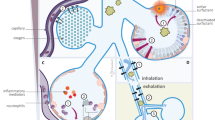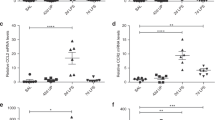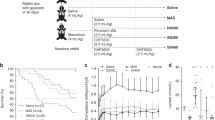Abstract
Meconium aspiration injures a number of cell types in the lung, most notably airway and alveolar epithelial lining cells. Recent data show that at least some of the cell death induced by meconium occurs by apoptosis, and therefore has the potential for pharmacologic inhibition through the use of apoptosis blockers or other strategies. Related work in adult animal models of lung injury has shown that apoptosis of lung epithelial cells induces a local (that is, entirely lung tissue specific) renin-angiotensin system (RASL). Furthermore, this inducible RASL is required for the apoptotic response and affects other adjacent cell types through the release of angiotensin II and related peptides. This manuscript reviews the published data supporting this viewpoint as well as more recent works that suggest the involvement of a RASL in the perinatal lung damage associated with meconium aspiration syndrome (MAS). The implications of these findings regarding their potential for the clinical management of MAS are also discussed.
This is a preview of subscription content, access via your institution
Access options
Subscribe to this journal
Receive 12 print issues and online access
$259.00 per year
only $21.58 per issue
Buy this article
- Purchase on Springer Link
- Instant access to full article PDF
Prices may be subject to local taxes which are calculated during checkout
Similar content being viewed by others
References
Edinger AL, Thompson CB . Death by design: apoptosis, necrosis and autophagy. Curr Opin Cell Biol 2004; 16 (6): 663–669.
Fink SL, Cookson BT . Apoptosis, pyroptosis, and necrosis: mechanistic description of dead and dying eukaryotic cells. Infect Immun 2005; 73 (4): 1907–1916.
Krantic S, Mechawar N, Reix S, Quirion R . Apoptosis-inducing factor: a matter of neuron life and death. Prog Neurobiol 2007; 81 (3): 179–196.
Li X, Shu R, Filippatos G, Uhal BD . Apoptosis in lung injury and remodeling. J Applied Physiol. Invited Review, 2004; 97 (4): 1535–1542.
Albertine KH, Soulier MF, Wang Z, Ishizaka A, Hashimoto S, Zimmerman GA et al. Fas and fas ligand are up-regulated in pulmonary edema fluid and lung tissue of patients with acute lung injury and the acute respiratory distress syndrome. Am J Pathol 2002; 161: 1783–1796.
Hodge SJ, Hodge GL, Reynolds PN, Scicchitano R, Holmes M . Increased production of TGF-beta and apoptosis of T lymphocytes isolated from peripheral blood in COPD. Am J Physiol Lung Cell Mol Physiol 2003; 285 (2): L492–L499.
Matute-Bello G, Liles WC, Steinberg KP, Kiener PA, Mongovin S, Chi EY et al. Soluble Fas ligand induces epithelial cell apoptosis in humans with acute lung injury (ARDS). J Immunol 1999; 163: 2217–2225.
Ware LB, Matthay MA . Alveolar fluid clearance is impaired in the majority of patients with acute lung injury and the acute respiratory distress syndrome. Am J Respir Crit Care Med 2001; 163: 1376–1383.
Guinee D, Brambilla E, Fleming M, Hayashi T, Rahn M, Koss M et al. The potential role of BAX and BCL-2 expression in diffuse alveolar damage. Am J Pathol 1997; 151: 999–1007.
Husain KD, Stromberg PE, Javadi P, Buchman TG, Karl IE, Hotchkiss RS et al. Bcl-2 inhibits gut epithelial apoptosis induced by acute lung injury in mice but has no effect on survival. Shock 2003; 20: 437–443.
Pittet JF, Mackersie RC, Martin TR, Matthay MA . Biological markers of acute lung injury: prognostic and pathogenetic significance. Am J Respir Crit Care Med 1997; 155: 1187–1205.
Goodman ER, Stricker P, Velavicius M, Fonseca R, Kleinstein E, Lavery R et al. Role of granulocyte-macrophage colony-stimulating factor and its receptor in the genesis of acute respiratory distress syndrome through an effect on neutrophil apoptosis. Arch Surg 1999; 134: 1049–1054.
Matute-Bello G, Liles WC, Radella II F, Steinberg KP, Ruzinski JT, Hudson LD et al. Modulation of neutrophil apoptosis by granulocyte colony-stimulating factor and granulocyte/macrophage colony-stimulating factor during the course of acute respiratory distress syndrome. Crit Care Med 2000; 28: 1–7.
Parsey MV, Kaneko D, Shenkar R, Abraham E . Neutrophil apoptosis in the lung after hemorrhage or endotoxemia: apoptosis and migration are independent of IL-1beta. Clin Immunol 1999; 91: 219–225.
Matute-Bello G, Liles WC, Radella II F, Steinberg KP, Ruzinski JT, Hudson LD et al. Modulation of neutrophil apoptosis by granulocyte colony-stimulating factor and granulocyte/macrophage colony-stimulating factor during the course of acute respiratory distress syndrome. Crit Care Med 2000; 28: 1–7.
Klein JB, Rane MJ, Scherzer JA, Coxon PY, Kettritz R, Mathiesen JM et al. Granulocyte-macrophage colony-stimulating factor delays neutrophil constitutive apoptosis through phosphoinositide 3-kinase and extracellular signal-regulated kinase pathways. J Immunol 2000; 164: 4286–4291.
Leuenroth SJ, Grutkoski PS, Ayala A, Simms HH . The loss of Mcl-1 expression in human polymorphonuclear leukocytes promotes apoptosis. J Leukoc Biol 2000; 68: 158–166.
Derouet M, Thomas L, Cross A, Moots RJ, Edwards SW . GM-CSF signalling and proteasome inhibition delay neutrophil apoptosis by increasing the stability of Mcl-1. J Biol Chem 2004; 279 (26): 26915–26921.
Hamacher J, Lucas R, Lijnen HR, Buschke S, Dunant Y, Wendel A et al. Tumor necrosis factor-alpha and angiostatin are mediators of endothelial cytotoxicity in bronchoalveolar lavages of patients with acute respiratory distress syndrome. Am J Respir Crit Care Med 2002; 166: 651–656.
Luca R, Lijnen HR, Suffredini AF, Pepper MS, Steinberg KP, Martin TR et al. Increased angiostatin levels in bronchoalveolar lavage fluids from ARDS patients and from human volunteers after lung instillation of endotoxin. Thromb Haemost 2002; 87: 966–971.
Machino T, Hashimoto S, Maruoka S, Gon Y, Hayashi S, Mizumura K et al. Apoptosis signal-regulating kinase 1-mediated signaling pathway regulates hydrogen peroxide-induced apoptosis in human pulmonary vascular endothelial cells. Crit Care Med 2003; 31: 2776–2781.
Kasahara Y, Tuder RM, Cool CD, Voelkel NF . Expression of 15-lipoxygenase and evidence for apoptosis in the lungs from patients with COPD. Chest 2000; 117 (5 Suppl 1): 260S.
Kelly MG, Elborn JS, Kelly MG, Brown V, Ennis M . Measuring granulocyte apoptosis in airway inflammation. Thorax 2002; 57 (4): 376; author reply 376. 30: Imai K, D'Armiento J. Differential gene expression of sFRP-1 and apoptosis in pulmonary emphysema. Chest. 2002;121(3 Suppl):7S.
Majo J, Ghezzo H, Cosio MG . Lymphocyte population and apoptosis in the lungs of smokers and their relation to emphysema. Eur Respir J 2001; 17 (5): 946–953.
Yokohori N, Aoshiba K, Nagai A, Respiratory Failure Research Group in Japan. Increased levels of cell death and proliferation in alveolar wall cells in patients with pulmonary emphysema. Chest 2004; 125 (2): 626–632.
Aoshiba K, Yokohori N, Nagai A . Alveolar wall apoptosis causes lung destruction and emphysematous changes. Am J Respir Cell Mol Biol 2003; 28: 555–562.
Ishii T, Fujishiro M, Masuda M, Nakajima J, Teramoto S, Ouchi Y et al. Depletion of glutathione S-transferase P1 induces apoptosis in human lung fibroblasts. Exp Lung Res 2003; 29 (7): 523–536.
Ishii T, Matsuse T, Igarashi H, Masuda M, Teramoto S, Ouchi Y . Tobacco smoke reduces viability in human lung fibroblasts: protective effect of glutathione S-transferase P1. Am J Physiol Lung Cell Mol Physiol 2001; 280 (6): L1189–L1195.
Tsao PN, Su YN, Li H, Huang PH, Chien CT, Lai YL et al. Overexpression of placenta growth factor contributes to the pathogenesis of pulmonary emphysema. Am J Respir Crit Care Med 2004; 169 (4): 505–511.
Kasahara Y, Tuder RM, Taraseviciene-Stewart L, Le Cras TD, Abman S, Hirth PK et al. Inhibition of VEGF receptors causes lung cell apoptosis and emphysema. J Clin Invest 2000; 106 (11): 1311–1319.
Lucey EC, Keane J, Kuang PP, Snider GL, Goldstein RH . Severity of elastase-induced emphysema is decreased in tumor necrosis factor-alpha and interleukin-1beta receptor-deficient mice. Lab Invest 2002; 82 (1): 79–85.
Takabatake N, Nakamura H, Inoue S, Terashita K, Yuki H, Kato S et al. Circulating levels of soluble Fas ligand and soluble Fas in patients with chronic obstructive pulmonary disease. Respir Med 2000; 94 (12): 1215–1220.
Yasuda N, Gotoh K, Minatoguchi S, Asano K, Nishigaki K, Nomura M et al. An increase of soluble Fas, an inhibitor of apoptosis, associated with progression of COPD. Respir Med 1998; 92 (8): 993–999.
Kuwano K, Kunitake R, Kawasaki M . p21 and p53 expression in association with DNA strand breaks in idiopathic pulmonary fibrosis. Am J Respir Crit Care Med 1996; 154: 477–483.
Hagimoto N, Kuwano K, Nomoto Y, Kunitake R, Hara N . Apoptosis and expression of Fas/Fas ligand mRNA in bleomycin-induced pulmonary fibrosis in mice. Am J Respir Cell Mol Biol 1997; 16: 91–101.
Wang R, Ibarra-Sunga O, Verlinski L, Pick R, Uhal BD . Abrogation of bleomycin-induced epithelial apoptosis and lung fibrosis by captopril or by a caspase inhibitor. Am J Physiol Lung Cell Mol Physiol 2000; 279: L143–L151.
Uhal BD, Joshi I, Hughes WF, Ramos C, Pardo A, Selman M . AEC death adjacent to underlying myofibroblasts in advanced fibrotic human lung. Am J Physiol 1998; 275: L1192–L1199.
Kuwano K, Kunitake R, Maeyama T, Hagimoto N, Kawasaki M, Matsuba T et al. Attenuation of bleomycin-induced pneumopathy in mice by a caspase inhibitor. Am J Physiol Lung Cell Mol Physiol 2001; 280: L316–L325.
Inoshima I, Kuwano K, Hamada N, Hagimoto N, Yoshimi M, Maeyama T et al. Anti-monocyte chemoattractant protein-1 gene therapy attenuates pulmonary fibrosis in mice. Am J Physiol Lung Cell Mol Physiol 2004; 286: L1038–L1044.
Domagala-Kulawik J, Droszcz P, Kraszewska I, Chazan R . Expression of Fas antigen in the cells from bronchoalveolar lavage fluid (BALF). Folia Histochem Cytobiol 2000; 38: 185–188.
Kazufumi M, Sonoko N, Masanori K, Takateru I, Akira O . Expression of bcl-2 protein and APO-1 (Fas antigen) in the lung tissue from patients with idiopathic pulmonary fibrosis. Microsc Res Tech 1997; 38: 480–487.
Kuwano K, Maeyama T, Inoshima I, Ninomiya K, Hagimoto N, Yoshimi M et al. Increased circulating levels of soluble Fas ligand are correlated with disease activity in patients with fibrosing lung diseases. Respirology 2002; 7: 15–21.
Hagimoto N, Kuwano K, Miyazaki H . Induction of apoptosis and pulmonary fibrosis in mice in response to ligation of FAS antigen. Am J Respir Cell Mol Biol 1997; 17: 272–278.
Hagimoto N, Kuwano K, Nomoto Y, Kunitake R, Hara N . Apoptosis and expression of Fas/Fas ligand mRNA in bleomycin-induced pulmonary fibrosis in mice. Am J Respir Cell Mol Biol 1997; 16: 91–101.
Aoshiba K, Yasui S, Tamaoki J, Nagai A . The Fas/Fas-ligand system is not required for bleomycin-induced pulmonary fibrosis in mice. Am J Respir Crit Care Med 2000; 162: 695–700.
Matsuoka H, Arai T, Mori M, Goya S, Kida H, Morishita H et al. p38 MAPK inhibitor, FR-167653, ameliorates murine bleomycin-induced pulmonary fibrosis. Am J Physiol Lung Cell Mol Physiol 2022; 283: L103–L112.
Yoshida K, Kuwano K, Hagimoto N, Watanabe K, Matsuba T, Fujita M et al. MAP kinase activation and apoptosis in lung tissues from patients with idiopathic pulmonary fibrosis. J Pathol 2002; 198: 388–396.
Filippatos G, Tilak M, Pinillos H, Uhal BD . Regulation of apoptosis by angiotensin II in the heart and lungs (Invited Review). Int J Mol Med 2001; 7 (3): 273–280.
Von Lutterotti N, Catanzaro DF, Sealey JE, Laragh JH . Renin is not synthesized by cardiac and extrarenal vascular tissues. A review of experimental evidence. Circulation 1994; 89: 458–470.
Atlas SS . The renin angiotensin system revisited: classical and nonclassical pathways of angiotensin formation. Mount Sinai J Med 1998; 65: 87–96.
Molteni A, Ward W, Ts'ao C, Solliday N, Dunne M . Monocrotaline-induced pulmonary fibrosis in rats: amelioration by captopril and penicillamine. Proc Soc Exp Biol Med 1985; 180: 112–120.
Wang R, Ibarra-Sunga O, Pick R, Uhal BD . Abrogation of bleomycin-induced epithelial apoptosis and lung fibrosis by captopril or by a caspase inhibitor. Am J Physiol Lung Cell Mol Physiol 2000; 279: L143–L151.
Mohammadi-Karakani A . Lisinopril ameliorates paraquat-induced lung fibrosis. Clin Chim Acta 2006; 367 (1–2): 170–174.
Li X, Zhang H, Soledad-Conrad V, Zhuang J, Uhal BD . Bleomycin-induced apoptosis of alveolar epithelial cells requires angiotensin synthesis de novo. Am J Physiol 2003; 284 (3): L501–L507.
Wang R, Alam G, Zagariya A, Gidea G, Pinillos H, Lalude O et al. Apoptosis of lung epithelial cells in response to TNF-alpha requires angiotensin II generation de novo. J Cell Physiol 2000; 185 (2): 253–259.
Molteni A, Moulder JE, Cohen EF, Ward WF, Fish BL, Taylor JM et al. Control of radiation-induced pneumopathy and lung fibrosis by angiotensin-converting enzyme inhibitors and an ANG II type 1 receptor blocker. Int J Radiat Biol 2000; 76: 523–532.
Li X, Rayford H, Uhal BD . Essential roles for angiotensin receptor AT1a in bleomycin-induced apoptosis and lung fibrosis in mice. Am J Pathol 2003; 163 (6): 2523–2530.
Otsuka M, Takahashi H, Shiratori M, Chiba H, Abe S . Reduction of bleomycin induced lung fibrosis by candesartan cilexetil, an angiotensin II type 1 receptor antagonist. Thorax 2004; 59 (1): 31–38.
Uhal BD, Wang R, Laukka J, Zhuang J, Soledad-Conrad V, Filippatos G . Inhibition of amiodarone-induced lung fibrosis but not alveolitis by angiotensin system antagonists. Pharmacol Toxicol 2003; 92: 81–87.
Wang R, Zagariya A, Ibarra-Sunga O, Gidea C, Ang E, Deshmukh S et al. Angiotensin II induces apoptosis in human and rat alveolar epithelial cells. Am J Physiol 1999; 276: L885–L889.
Papp M, Li X, Zhuang J, Wang R, Uhal BD . Angiotensin receptor subtype AT1 mediates alveolar epithelial cell apoptosis in response to ANGII. Am J Physiol 2002; 282: L713–L718.
Wang R, Zagariya A, Ang E, Ibarra-Sunga E, Uhal BD . Fas-induced apoptosis of alveolar epithelial cells requires angiotensin II generation and receptor interaction. Am J Physiol 1999; 277: L1245–L1250.
Uhal B, Zhang H, Abdul-Hafez A, Shu R, Uhal BD . Amiodarone induces angiotensinogen gene expression in lung alveolar epithelial cells through AP-1. Basic Clin Pharmacol Toxicol 2007; 100: 59–66.
Li X, Rayford H, Shu R, Zhuang J, Uhal BD . Essential role for cathepsin D in bleomycin-induced apoptosis of alveolar epithelial cells. Am J Physiol 2004; 287 (1): L46–L51.
Li X, Molina-Molina M, Abdul-Hafez A, Ramirez J, Serrano-Mollar A, Xaubet A et al. Extravascular sources of lung angiotensin peptide synthesis in idiopathic pulmonary fibrosis. Am J Physiol Lung Cell Mol Physiol 2006; 291 (5): L887–L895.
Lu MP, Du LZ, Gu WZ, Chen XX . Nitric oxide inhalation inhibits inducible nitric oxide synthase but not nitrotyrosine formation and cell apoptosis in rat lungs with meconium-induced injury. Acta Pharmacol Sin 2005; 26 (9): 1123–1129.
Zagariya A, Bhat R, Chari G, Uhal B, Navale S, Vidyasagar D . Apoptosis of airway epithelial cells in response to meconium. Life Sci 2005; 76 (16): 1849–1858.
Zagariya A, Bhat R, Navale S, Chari G, Vidyasagar D . Inhibition of meconium-induced cytokine expression and cell apoptosis by pretreatment with captopril. Pediatrics 2006; 117 (5): 1722–1727.
Lukkarinen H, Laine J, Lehtonen J, Zagariya A, Vidyasagar D, Aho H et al. Angiotensin II receptor blockade inhibits pneumocyte apoptosis in experimental meconium aspiration. Pediatr Res 2004; 55 (2): 326–333.
Author information
Authors and Affiliations
Corresponding author
Rights and permissions
About this article
Cite this article
Uhal, B., Abdul-Hafez, A. Angiotensin II in apoptotic lung injury: potential role in meconium aspiration syndrome. J Perinatol 28 (Suppl 3), S108–S112 (2008). https://doi.org/10.1038/jp.2008.149
Published:
Issue Date:
DOI: https://doi.org/10.1038/jp.2008.149
This article is cited by
-
COVID-19 and the Renin Angiotensin System: Implications for the Older Adults
The Journal of nutrition, health and aging (2020)



